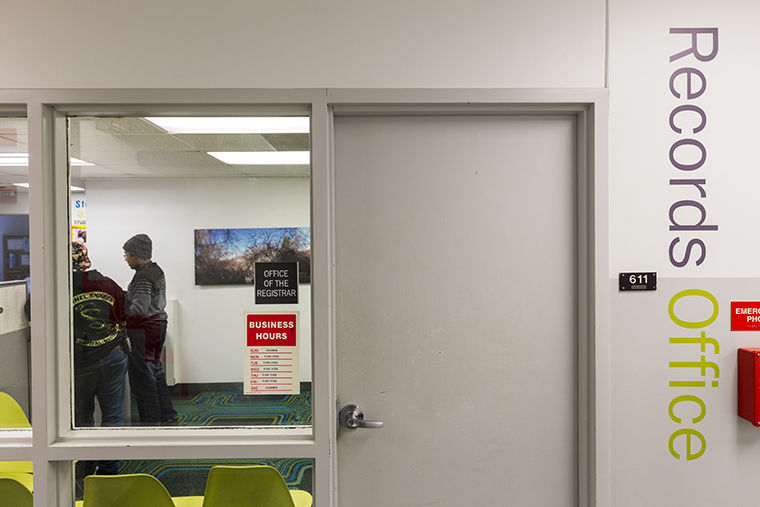Registrar to centralize course scheduling
March 5, 2018

The Columbia College Chicago Records Office in 600 S. Michigan Ave.
The college is planning the centralization of course registration, including changes to course numbers and academic scheduling with departments and the Office of the Registrar.
During a Jan. 25 meeting held at 600 S. Michigan Ave., school deans, associate deans, the Office of the Registrar, department chairs and staff who assist with academic scheduling, Senior Vice President and Provost Stan Wearden and Senior Associate Provost Suzanne Blum-Malley discussed the shift, which would be implemented with the help of new software.
The college’s current decentralized model of scheduling, for which each department handles its own schedule, will be changed to a centralized or “intentional” model, college spokeswoman Anjali Julka said.
Julka did not provide The Chronicle interviews with Wearden and Registrar Keri Walters but instead provided emailed statements from the News Office and Wearden.
Julka said Wearden and Walters discussed the standardized software system’s benefits with coordinating academic scheduling at the college. Wearden has also ordered the Office of the Registrar to explore software options, according to a Jan. 31 emailed statement to The Chronicle.
“This system would potentially facilitate a more streamlined and holistic registration experience for students, and would increase use of underutilized classroom facilities and timeframes,” the statement read. “Additionally, the Office of the Registrar will work with students, staff and other stakeholders over the duration of this multi-year project to obtain input and feedback.”
In a Feb. 5 email to The Chronicle from the News Office, Wearden said courses are scheduled separately by each department in the current decentralized model. In the intentional model, also described as a “shared” model, data would be used to increase space and time efficiency for students as well as avoid scheduling conflicts. Programming would factor in degree and space requirements as well as student and faculty preferences.
Wearden also stated in the email that the changes, which have been discussed since August 2016, are a multi-year project with no set timeline. The project will regularly include feedback from faculty, academic schedulers, deans, associate deans, chairs and students.
Scheduling with individual departments no longer works because departments are now housed in multiple buildings instead of one, said Tom Dowd, associate dean of the School of Media Arts and acting chair of the Audio Arts and Acoustics Department.
“We’re just looking at aligning ourselves more with national best practice about how schedules are assembled,” Dowd said, “and how that information is presented and distributed to students so they can make better long-term decisions about their schedule.”
The system’s goal, highlighted at the Jan. 25 meeting, is to facilitate students’ graduation paths with multiple course options, said Oscar Valdez, an academic scheduling coordinator in the Humanities, History and Social Sciences Department, in a Feb. 1 emailed statement to The Chronicle.
Valdez, who is also a 2004 journalism alumnus, said while he was attending the college, he was forced to take evening and Saturday courses after accepting a full-time job as a student employee in the HHSS Department.
“The flatten[ing] of the schedule is something we have already incorporated in the HHSS LAS Core, but having all major courses follow this format will be a great service for students,” Valdez said in the statement. “If we can advertise ourselves as an institution that allows students to have multiple course options for graduation, we are in the right path in serving our students better.”
Wearden stated in the Feb. 5 email that because the college has yet to choose software to implement these changes, the shift’s costs are not known. However, the current scheduling system has also been found to be costly for the college, he added.
“We have evidence that scheduling conflicts make it difficult for students to graduate on time. Streamlining the schedule will make it easier for students to register for the courses they need in the sequence they need them, leading to increased graduation rates,” Wearden said. “The college may have more academic space than it currently needs, and the upkeep of this space is expensive to maintain. Once space is maximized, we can better equip and improve the spaces we use, which makes the best use of our resources.”
In a Feb. 20 email announcement to students, the Office of the Registrar announced course calalog enhancements beginning in the Fall 2018 Semester.
According to the email, courses were renumbered for easier identification. The prefixing system is alphabetical and indicates the course’s discipline, while the new numbering system contains three digits rather than four. Students should determine which courses to take for fall 2018 with advising guides when the schedule is published March 19, Walters said in the email. Students should also note the new course numbers using the new Course Number Look-Up Tool on the college’s website. Because Oasis has been programmed to accept the new course numbers, students should not experience difficulties while using advising guides or during registration, the email stated.
Registration begins April 2 and students will receive registration dates and times in a separate email by approximately March 7, according to the email.
“We’re pleased to bring the new course numbering system to Columbia as it is much like systems in place at other colleges and universities,” the Feb. 20 email stated. “It will make selecting courses more intuitive and your academic transcripts easier to read and understand.”







